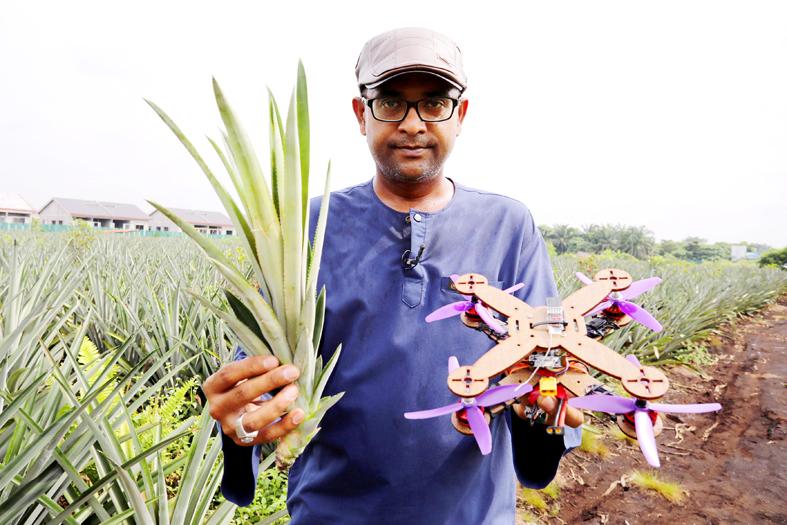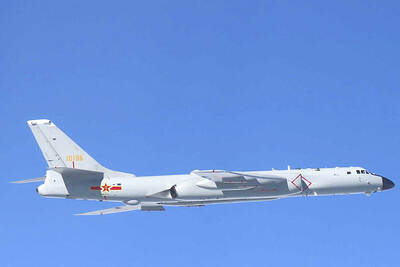Malaysian researchers have developed a method to transform the fiber found in normally discarded pineapple leaves to make a strong material that can be used to build the frames for uncrewed aircraft, or drones.
The project, headed by Mohamed Thariq Hameed Sultan, a professor at the University Putra Malaysia, has been trying to find sustainable uses for pineapple waste generated by farmers in Hulu Langat, an area about 65km from Kuala Lumpur.
“We are transforming the leaf of the pineapple into a fiber that can be used for aerospace application, basically inventing a drone,” he said at a workshop.

Photo: Reuters
He said that drones made out of the bio-composite material had a higher strength-to-weight ratio than those made from synthetic fibers, and were also cheaper, lighter and easier to dispose.
If the drone was damaged, the frame could be buried in the ground and would degrade within two weeks, he said.
The prototype drones have been able to fly to a height of about 1,000m and stay in the air for about 20 minutes, he added.
Ultimately, the research team hopes to create a larger drone to accommodate bigger payloads, including image sensors, for agricultural purposes and aerial inspections.
“Our role here is to help the industry, the farmers, to increase their yield and make their jobs much easier,” said William Robert Alvisse of the Malaysian Unmanned Drones Activist Society, a non-governmental group helping to design the drone and advising on the project.
Before the project launched in 2017, pineapple stems were discarded after the once-in-a-year harvest period, but farmers hope the drones project will encourage more innovation to find uses for the waste and boost incomes.
“With the health issue, the economy problem due to COVID-19, the society is desperate and there is no alternative to increase income,” pineapple farmer Irwan Ismail said.

PARLIAMENT CHAOS: Police forcibly removed Brazilian Deputy Glauber Braga after he called the legislation part of a ‘coup offensive’ and occupied the speaker’s chair Brazil’s lower house of Congress early yesterday approved a bill that could slash former Brazilian president Jair Bolsonaro’s prison sentence for plotting a coup, after efforts by a lawmaker to disrupt the proceedings sparked chaos in parliament. Bolsonaro has been serving a 27-year term since last month after his conviction for a scheme to stop Brazilian President Luiz Inacio Lula da Silva from taking office after the 2022 election. Lawmakers had been discussing a bill that would significantly reduce sentences for several crimes, including attempting a coup d’etat — opening up the prospect that Bolsonaro, 70, could have his sentence cut to

China yesterday held a low-key memorial ceremony for the 1937 Nanjing Massacre, with Chinese President Xi Jinping (習近平) not attending, despite a diplomatic crisis between Beijing and Tokyo over Taiwan. Beijing has raged at Tokyo since Japanese Prime Minister Sanae Takaichi last month said that a hypothetical Chinese attack on Taiwan could trigger a military response from Japan. China and Japan have long sparred over their painful history. China consistently reminds its people of the 1937 Nanjing Massacre, in which it says Japanese troops killed 300,000 people in what was then its capital. A post-World War II Allied tribunal put the death toll

A passerby could hear the cacophony from miles away in the Argentine capital, the unmistakable sound of 2,397 dogs barking — and breaking the unofficial world record for the largest-ever gathering of golden retrievers. Excitement pulsed through Bosques de Palermo, a sprawling park in Buenos Aires, as golden retriever-owners from all over Argentina transformed the park’s grassy expanse into a sea of bright yellow fur. Dog owners of all ages, their clothes covered in dog hair and stained with slobber, plopped down on picnic blankets with their beloved goldens to take in the surreal sight of so many other, exceptionally similar-looking ones.

‘UNWAVERING ALLIANCE’: The US Department of State said that China’s actions during military drills with Russia were not conducive to regional peace and stability The US on Tuesday criticized China over alleged radar deployments against Japanese military aircraft during a training exercise last week, while Tokyo and Seoul yesterday scrambled jets after Chinese and Russian military aircraft conducted joint patrols near the two countries. The incidents came after Japanese Prime Minister Sanae Takaichi triggered a dispute with Beijing last month with her remarks on how Tokyo might react to a hypothetical Chinese attack on Taiwan. “China’s actions are not conducive to regional peace and stability,” a US Department of State spokesperson said late on Tuesday, referring to the radar incident. “The US-Japan alliance is stronger and more